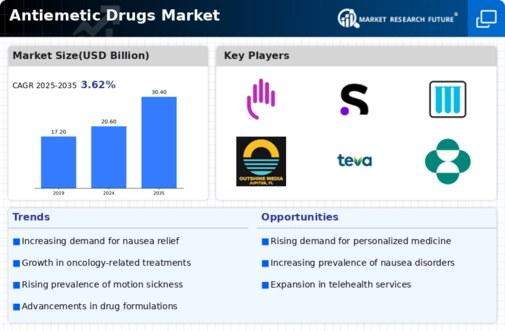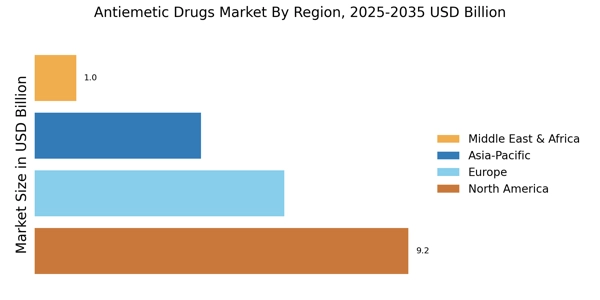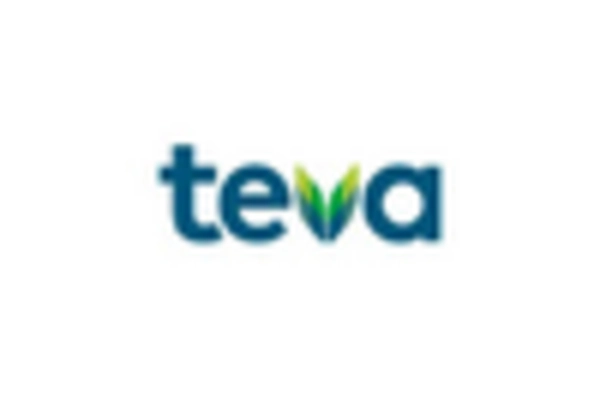Rising Geriatric Population
The Antiemetic Drugs Market is significantly influenced by the rising geriatric population, which is more susceptible to conditions that cause nausea and vomiting. Older adults often experience comorbidities and are frequently prescribed multiple medications, increasing the likelihood of adverse effects such as nausea. According to demographic studies, the population aged 65 and older is projected to reach 1.5 billion by 2050, creating a substantial market for antiemetic drugs. This demographic shift necessitates the development of tailored antiemetic therapies that address the unique needs of elderly patients. Consequently, the Antiemetic Drugs Market is likely to see increased demand as healthcare systems adapt to this growing population.
Regulatory Support for Drug Approvals
The Antiemetic Drugs Market is positively impacted by regulatory support for the approval of new antiemetic drugs. Regulatory agencies are increasingly recognizing the need for effective treatments for nausea and vomiting, leading to streamlined approval processes for innovative therapies. This supportive regulatory environment encourages pharmaceutical companies to invest in the development of new antiemetic agents, which can address unmet medical needs. Recent initiatives have aimed to expedite the review of drugs that demonstrate significant benefits for patients suffering from severe nausea. As a result, the Antiemetic Drugs Market is likely to expand, with a growing number of effective treatment options becoming available to patients.
Growing Awareness of Treatment Options
The Antiemetic Drugs Market is experiencing a surge in demand due to the growing awareness of available treatment options among patients and healthcare providers. Educational campaigns and increased access to information have empowered patients to seek effective antiemetic therapies for their conditions. This heightened awareness is particularly evident in oncology, where patients are more informed about the side effects of chemotherapy and the importance of managing nausea. As a result, healthcare professionals are more likely to prescribe antiemetic medications, contributing to the overall growth of the Antiemetic Drugs Market. The market is expected to expand as more patients advocate for their treatment needs.
Advancements in Pharmaceutical Research
The Antiemetic Drugs Market is benefiting from advancements in pharmaceutical research, which are leading to the development of novel antiemetic agents. Research initiatives are focusing on understanding the underlying mechanisms of nausea and vomiting, resulting in the discovery of new drug classes that offer improved efficacy and safety profiles. For instance, the introduction of neurokinin-1 receptor antagonists has shown promise in managing chemotherapy-induced nausea. The market is projected to witness a compound annual growth rate of around 6% over the next few years, driven by these innovations. As pharmaceutical companies invest in research and development, the Antiemetic Drugs Market is poised for substantial growth.
Increasing Incidence of Nausea and Vomiting Disorders
The Antiemetic Drugs Market is experiencing growth due to the rising incidence of nausea and vomiting disorders, which are prevalent in various medical conditions. Conditions such as chemotherapy-induced nausea, postoperative nausea, and motion sickness contribute significantly to the demand for antiemetic drugs. According to recent data, approximately 70% of cancer patients undergoing chemotherapy experience nausea, necessitating effective antiemetic treatments. This increasing patient population drives pharmaceutical companies to innovate and expand their product offerings in the antiemetic drugs sector. As healthcare providers seek to improve patient quality of life, the focus on effective management of these symptoms is likely to bolster the Antiemetic Drugs Market further.


















Leave a Comment